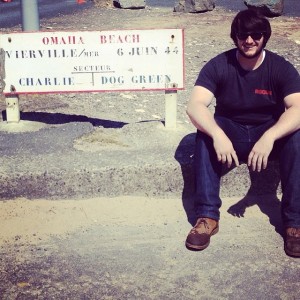During our time in Normandy, we had the opportunity to visit the German, American, and British Cemeteries, which became the final resting place of the thousands of soldiers who lost their lives in the fierce fighting for the region in 1944. Our first stop after Utah Beach was the German Cemetery. In the center, a single, solemn hill with a large stone cross overlooks the gravestones. The gravestones are small, flat, and dark. Each offers the names of multiple soldiers interned at the site. The small cemetery offers little information of the soldiers besides their name and date of death. Its simplicity offers somberness. Men old enough to be my father and boys years younger than myself rest under my feet. I am moved by this thought. They were our enemies. But they too were human.
The next day, we walked the grounds of the American Cemetery overlooking the English Channel and Omaha Beach. As we laid roses at each of the thirteen Buckeyes who lost their lives in the Normandy campaign and were laid to rest in the cemetery here, I pause to stop at several graves. Reading a name, rank, and date of death does not give much information on the individual soldier, yet each time I look up from the headstone, I look beyond the Cross or Star of David and see row after row of graves. The numbers are overwhelming. Here I get my first understanding of how many U.S. servicemen gave their lives. The numbers we studied in class become more than numbers—they become individuals. Despite this feeling, I found it difficult to understand the story of each individual grave. Thousands of white Crosses blended together. Eventually, they all seemed the same.
It wasn’t until I visited the British Cemetery the next day that I felt a personal connection and understanding of the thousands of men buried at these military sites. Walking along the rows of headstones, I read the names engraved on each marble stone. The face of the marker bore the insignia of the soldier’s unit, his rank, the date of death, an optional religious sign, and a short quote chosen by a loved one from home. Through these quotes, I really felt that a personal touch was added to the remembrance of those who sacrificed.
While psalms, poems, and one-line obituaries adorned the majority of headstones, one quote stood out to me. It read: “Peace Lad, You Played the Game.” I stopped walking and thought about what this game could be. It occurred to me that nations had gone to war, but men had lost their lives. Individuals had paid the greatest price in this supposed game of nations. The British Cemetery, to me, honored and respected the individuals who perished in special ways. The German and U.S. cemeteries had seemed uniform and impersonal in contrast.
Furthermore, many German and some Polish, African, Soviet, Czech, and Arabic soldiers were buried at the British Cemetery. This served to remind me of the widespread impact World War Two had, and how much death it brought. Seeing such foreign, especially German, headstones intermixed with British, Canadian, and Irish gravestones was surprising. My mind wandered once again to the “You Played the Game” epitaph. Each of these young men was forced to play a deadly game. Perhaps they were similar to each other. Perhaps they might have been friends. Perhaps they had a family. Many were fathers. All were sons.
Visiting the cemeteries demonstrated that all these men were individuals to me. In class, we read books and remember numbers of casualties in specific battles; however, until we walk the rows of the dead, we cannot fathom the true cost of the war.

